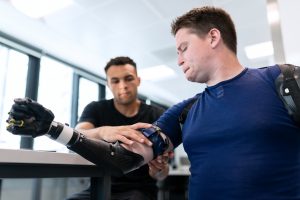Occupational Therapist, Physiotherapist and Occupational Therapist Assistants and Physiotherapist Assistants
by Eyiram Gawu-Mensah, Ben Ho, Grace Luu, and Maryse Plourde
What is the Role of an Occupational Therapist (OT)?
Occupational Therapists (OTs) are regulated healthcare professionals (Canadian Association of Occupational Therapists [CAOT], 2016). OTs can perform assessments, create treatment plans, and discharge clients. Occupational Therapy focuses on helping clients maintain or regain their ability to perform daily activities which matter most to them by removing barriers that stand in the way of their participation (CAOT, 2016).  Such activities include self-care (e.g., eating, dressing), productivity (e.g., work, school), or leisure activities (e.g., gardening, playing an instrument). OTs work closely with Occupational Therapist Assistant & Physiotherapist Assistants (OTA & PTA) and are accountable for understanding the level of education and training of the OTA & PTA to ensure the OTA & PTA is able to deliver competent client care in an effective and safe manner (COTO, 2018).
Such activities include self-care (e.g., eating, dressing), productivity (e.g., work, school), or leisure activities (e.g., gardening, playing an instrument). OTs work closely with Occupational Therapist Assistant & Physiotherapist Assistants (OTA & PTA) and are accountable for understanding the level of education and training of the OTA & PTA to ensure the OTA & PTA is able to deliver competent client care in an effective and safe manner (COTO, 2018).
What is the Role of a Physiotherapist (PT)?
Physiotherapists (PTs) are regulated healthcare professionals (Ministry of Health, 2018). PTs can perform assessments, diagnose, create treatment plans, and discharge clients. Physiotherapy addresses the impacts that disease, injury, or disability have on an individual’s mobility and function (National Physiotherapy Advisory Group [NPAG], 2017). PTs focus on health promotion, prevention, and rehabilitation (Ontario Physiotherapy Association [OPA], 2020).  Physiotherapy treatments can include therapeutic exercises such as stretching and strengthening, manual therapy, acupuncture, and other modalities (CPO, 2019). Physiotherapy is practiced primarily by Physiotherapists (PTs) and Physiotherapist Assistants (PTAs). PTs can work closely with OTA & PTA and are accountable for understanding the level of education and training of the OTA & PTA to ensure the OTA & PTA is able to deliver competent client care in an effective and safe manner (NPAG, 2012).
Physiotherapy treatments can include therapeutic exercises such as stretching and strengthening, manual therapy, acupuncture, and other modalities (CPO, 2019). Physiotherapy is practiced primarily by Physiotherapists (PTs) and Physiotherapist Assistants (PTAs). PTs can work closely with OTA & PTA and are accountable for understanding the level of education and training of the OTA & PTA to ensure the OTA & PTA is able to deliver competent client care in an effective and safe manner (NPAG, 2012).
What is the Role of an Occupational Therapist Assistant & Physiotherapist Assistant (OTA & PTA)?
An OTA & PTA is a healthcare provider who is dual trained to assist both an OT and/or PT. In the province of Ontario, colleges can either provide dual training as an OTA & PTA or training in one area. Depending on the province or territory, the designation or the amount of training can vary.
 OTA & PTAs can work in any environment or setting where an OT and/or PT works. Unlike OTs and PTs, however, OTA & PTAs are not regulated by a governing body. Their primary role is to carry out and assist in providing occupational therapy and physiotherapy treatments under the direction and supervision of a licensed OT and/or PT (COTO, 2018; NPAG, 2012).
OTA & PTAs can work in any environment or setting where an OT and/or PT works. Unlike OTs and PTs, however, OTA & PTAs are not regulated by a governing body. Their primary role is to carry out and assist in providing occupational therapy and physiotherapy treatments under the direction and supervision of a licensed OT and/or PT (COTO, 2018; NPAG, 2012).
OTs and PTs can increase the efficiency of their service delivery by assigning duties to an OTA & PTA who can assist with client interventions and education. OTAs work one on one with clients and can inform the OT and/or PT about the client’s condition and progress during treatment.
Interprofessional Collaboration
OTs, PTs, and OTA & PTAs work closely together, however, are part of a larger interprofessional team. Interprofessional collaboration (IPC) focuses on collaborating with other health disciplines to advocate for the client to provide client centred focused care.
These healthcare providers collaborative with the interprofessional team through sharing client information, communicating about client’s needs and documenting care provide to ensure optimal safe client care. Clients and their care partners are also included as part of the interprofessional team.
Some interprofessional collaboration roles that OTs, PTs, and OTA & PTAs are responsible for include:
- Understanding your role and responsibilities, as well as the roles of the client’s interprofessional team.
- Collaborating with the client to explore their preferences and making decisions about their care.
- Communicating with other healthcare providers in the interprofessional team to advocate for optimal client care.
- Demonstrating respectful interprofessional communication and interaction with all healthcare providers.
To learn more about the various roles, watch the following videos:
- OTA & PTA and student perspective Interview: https://www.youtube.com/watch?v=UZqMgD7J8qk
- OT Interview: https://youtu.be/amSQYwGCVok
- PT Interview: https://www.youtube.com/watch?v=hNRwDOSGhwM
Reference
Canadian Association of Occupational Therapists. (2016). What is Occupational Therapy? Retrieved 9 December 2020, from https://www.caot.ca/site/aboutot/whatisot?nav=sidebar
College of Occupational Therapists of Ontario. (2018). Standards for the Supervision of Occupational Therapist Assistants [Ebook] (p. 2). Retrieved 9 December 2020, from https://www.coto.org/docs/default-source/default-document-library/standards-for-the-supervision-of-occupational-therapist-assistants-2018.pdf?sfvrsn=f0051840_6
College of Physiotherapists of Ontario. (2019). What is Physiotherapy? Retrieved from https://www.collegept.org/patients/what-is-physiotherapy
College of Physiotherapists of Ontario. (2020). Physiotherapy Infection Control And Equipment Maintenance Standard. Retrieved from https://www.collegept.org/rules-and-resources/infection-control-equipment-maintenance
Ministry of Health. (2018). Regulated Health Professions. Retrieved from http://www.health.gov.on.ca/en/pro/programs/hhrsd/about/regulated_professions.aspx
National Physiotherapy Advisory Group. (2012). Essential Competency Profile for Physiotherapist Assistants in Canada.Retrieved from http://npag.ca/PDFs/Joint%20Initiatives/PTA%20profile%202012%20English.pdf
National Physiotherapy Advisory Group. (2017). Competency Profile For Physiotherapists In Canada (2017). Retrieved from https://www.collegept.org/docs/default-source/default-document-library/essentialcompetencyprofile2009.pdf?sfvrsn=614fc9a1_2
Ontario Physiotherapy Association. (2020). About Physiotherapy. Retrieved from https://opa.on.ca/about-physiotherapy/
Media Attributions
- Prosthetic Forearm – Image 1 © Photo by ThisIsEngineering from Pexels
- Rope Exercise – Image 2 © Photo by Cliff Booth from Pexels
- Quadricep Stretch in Prone – Image 3 © Photo by Kampus Production from Pexels

